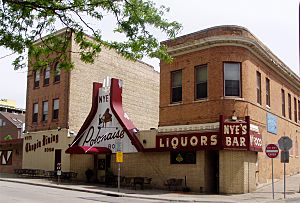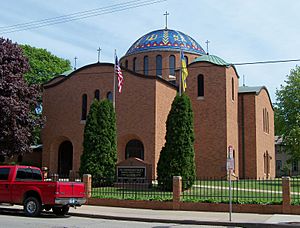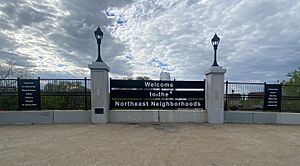Northeast, Minneapolis facts for kids
Quick facts for kids
Northeast
|
|
|---|---|
|
Community
|
|
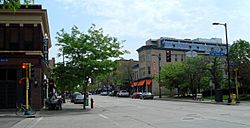
East Hennepin Avenue, looking north to the birthplace of Nordeast
|
|
| Nickname(s):
Nordeast, Old St. Anthony
|
|
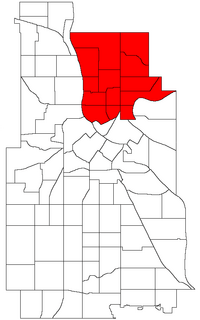
Northeast Community location within the City of Minneapolis
|
|
| Country | United States |
| State | Minnesota |
| County | Hennepin |
| City | Minneapolis |
| Founded | 1848 |
| Founded by | Franklin Steele |
| Named for | Saint Anthony Falls |
| City Council Wards | 1, 3 |
| Neighborhoods |
List
Audubon Park
Beltrami Bottineau Columbia Park Holland Logan Park Marshall Terrace Northeast Park Sheridan St. Anthony East St. Anthony West Waite Park Windom Park |
| Area | |
| • Total | 7.502 sq mi (19.43 km2) |
| Elevation | 974 ft (297 m) |
| Population
(2020)
|
|
| • Total | 38,410 |
| • Density | 5,120.0/sq mi (1,976.8/km2) |
| Time zone | UTC-6 (CST) |
| • Summer (DST) | UTC-5 (CDT) |
| Postal code |
55413, 55414, 55418, 55421
|
| Area code(s) | 612 |
| Website | http://www.ci.minneapolis.mn.us/neighborhoods/ |
Northeast is a special area, or "community," in Minneapolis, USA. It's made up of 13 smaller neighborhoods. You can tell if an address is in Northeast because it ends with "NE." Sometimes, people also include parts of the University community and the Old Saint Anthony business district, even if their addresses are "SE."
The Old Saint Anthony area is often seen as the heart of Northeast. This is because it's the oldest part of the city. It sits right across the Mississippi River from Downtown Minneapolis. Northeast is also called "Nordeast." This nickname comes from the many immigrants from northern and eastern Europe who settled here. Their languages influenced how people spoke.
Today, Northeast is a mix of old and new. You'll find historic buildings, classic homes, busy shopping streets, and industrial areas. But there are also new apartment buildings, modern stores, and a lively art scene. It's a place where people live and work. Some famous sights in Northeast are its beautiful churches and huge grain silos. Many buildings here were built in the late 1800s and early 1900s.
Before it became part of Minneapolis, this area was its own city called St. Anthony. Because of this, it can sometimes be confused with the city of Saint Anthony nearby.
Contents
History of Northeast Minneapolis

The story of Northeast Minneapolis began in 1848. A man named Franklin Steele bought land here. With help from Ard Godfrey, he built the first commercial mill. This mill was located at Saint Anthony Falls on the east side of the river. The falls were important because they were the farthest north boats could travel on the Mississippi River. They also provided strong power for mills. Soon, many mills were built, and the area became known as "Mill City."
In 1852, land on the west side of the Mississippi River opened up for settlement. This meant St. Anthony had a new neighbor and competitor across the river. St. Anthony officially became a city in 1855. This was 12 years before Minneapolis became a city. In 1872, St. Anthony and Minneapolis decided to join together. They became one big city called Minneapolis. The old St. Anthony area then became known as Northeast Minneapolis.
Growth and Changes Over Time
Northeast has changed a lot over the years. In the 1970s, the area was nearly a hundred years old. New apartment buildings were built, similar to those in downtown Minneapolis. Starting in 1990, a program helped local groups, residents, and businesses. It provided money for building projects. The city also improved streets and parks.
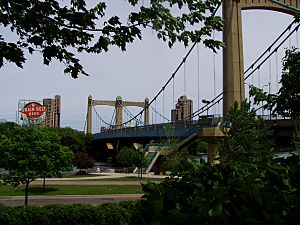
People in Northeast have also worked hard to protect its history. In the 1960s, there was a plan to build a highway through the area. Many residents fought against this plan. They succeeded, and the highway was never built. New homes and businesses were later built on the land that had been cleared. After this, a special historic area was created around the Pillsbury A Mill.
In the 1980s and 1990s, artists started moving to Northeast. They found old warehouses where they could live and work. Then, in 2011, a new law allowed breweries to open tap rooms. This brought many new breweries to the area. These changes have made Northeast a very popular place to live and visit.
Geography of Northeast
Northeast Minneapolis has clear boundaries. It's bordered by the city limits of Minneapolis to the north and east. The Mississippi River forms its western border. To the south, it's bordered by streets and train tracks. The city has official rules for these borders.
Most of Northeast is in City Council Ward 1. Some southern parts are in Ward 3. These wards are like districts, and each has a representative. Currently, Elliott Payne represents Ward 1, and Michael Rainville represents Ward 3.
The name "Northeast" comes from the city's street naming system. Streets west of the Mississippi River are called "North," "South," "East," or "West." Streets east of the river are called "Northeast" or "Southeast." The street that divides "Northeast" and "Southeast" addresses is East Hennepin Avenue. The highest point in Minneapolis is in or near Waite Park in Northeast, at 974 feet (297 meters) high.
People of Northeast
| Historical population | |||
|---|---|---|---|
| Census | Pop. | %± | |
| 1980 | 37,507 | — | |
| 1990 | 36,515 | −2.6% | |
| 2000 | 36,913 | 1.1% | |
| 2010 | 36,255 | −1.8% | |
| 2020 | 38,410 | 5.9% | |
Northeast Minneapolis has always been a place for working-class families. Many immigrants came here from countries like Lebanon, Poland, Finland, Germany, Slovakia, Russia, and Ukraine. They came for jobs in the grain and sawmills along the river. Later, they found jobs in factories and on the railroads. By 1930, almost 60% of the people in Northeast were immigrants. These Eastern European immigrants, especially Poles, greatly influenced the culture of Minneapolis.
The Polish culture is still strong in "Nordeast." Many local businesses have Polish names, like Kramarczuk's Deli and Siwek Lumber. The Adam Mickiewicz Polish Saturday School teaches classes at Holy Cross Church. The Twin Cities Polish Festival also returned to the area in 2009.
The Ukrainian American Community Center (UACC) is also in Northeast. It hosts a yearly festival celebrating Ukrainian culture and food.
In recent years, Northeast has become even more diverse. The population is younger, but many old "Nordeast" families still live here. Students from the nearby University of Minnesota often rent homes here, and some stay after they graduate. African Americans have moved to Northeast from other parts of the city, finding stable neighborhoods and affordable homes. New immigrant groups, like Somalis and Latin Americans, continue to make Northeast their home. Northeast Minneapolis is a big center for the Ecuadorian community. Some areas are even called "Little Cuenca," after a city in Ecuador where many immigrants came from. Most homes in Northeast are owned by the people who live in them, which helps keep the neighborhoods stable.
Economy and Business
Northeast has traditionally been a place for "blue-collar" jobs, meaning jobs that involve physical labor. While some of its big factories have gotten smaller, industry is still important here. Major companies like Canadian Pacific Railway, Burlington Northern, Graco, Xcel Energy, and Honeywell have facilities in Northeast.
A big change in recent years has been turning old factories into new spaces. Many old industrial buildings are now used for homes, offices, or art studios. For example, the Madison Lofts and Cream of Wheat Lofts used to be factories. Other buildings have become office spaces.
Since the late 1990s, new restaurants and shops have opened. These businesses attract people from all over the city. They often sit next to older, well-known places. For example, Kramarczuk's Sausage Company, a long-time favorite, is near newer restaurants.
Other busy shopping areas in Northeast include 13th Avenue and the 29th Avenue and Johnson Street area. Local bars have always been a big part of the community. Famous ones include Gasthof zur Gemütlichkeit/Mario's Keller Bar and Tony Jaros' River Garden. Nye's Polonaise, a very popular bar, closed in 2016.
The Hennepin Avenue Bridge, rebuilt in 1991, shows how Northeast has changed. It's designed like the first bridge across the Mississippi River, welcoming everyone to the area.
The Central Avenue area has also seen changes. Many new restaurants, especially those with international foods, have opened. There are also many specialty food markets. These include Latin American, South Asian, and Middle Eastern markets.
The Johnson Street Quarry was an old industrial site. It was cleaned up in 1996, and a year later, the Quarry Shopping Center opened. It has large stores like Cub Foods, Target, and Home Depot.
Arts and Culture
Northeast has become a hub for artists. Many art galleries and studios are now in historic industrial buildings. The Northrup King Building is a great example. It was once a seed company, but now it's home to over 135 tenants, including 100 artists. Other buildings like the Grain Belt Brewery complex and the California Building also house many artists.
The Q'arma Building on Quincy Street is another important art spot. It has Altered Esthetics, an art gallery that shows new art every month. They have different themes, like Video Game Art or The Art of Service. Artists from all over the world want to show their work here.
A popular event is "Art-A-Whirl." This art crawl happens every May and features over 400 art studios. The Northeast Minneapolis Arts Association (NEMAA) started Art-A-Whirl in 1996. They also helped create the Northeast Minneapolis Arts District, which was officially recognized by the city in 2002.
For performing arts, the Ritz Theater on 13th Avenue Northeast is home to Theater Latté Da. This company puts on musical theater shows. The theater was renovated in 2006 and has helped bring new shops and restaurants to the area.
Churches and Religion
Northeast Minneapolis is known for its many churches. The first church in Minneapolis, Our Lady of Lourdes Church, was founded in 1849. Four of Minneapolis' five historic Polish churches are in Northeast: Holy Cross, All Saints, St. Hedwig, and Sacred Heart of Jesus Polish National Catholic Church. Holy Cross still has Mass in Polish.
Other Catholic churches serve different ethnic groups. St. Maron is for Lebanese people, St. John's Byzantine Rite for Rusyn people, St. Constantine's for Ukrainians, and St. Boniface for Germans.
Northeast also played a role in the history of the Orthodox Church in the United States. St. Alexis Toth founded the first Orthodox seminary in the U.S. at St. Mary's Orthodox Cathedral. St. Alexis helped many Eastern Rite Catholics convert to the Russian Orthodox Church. He is honored as a saint in the Orthodox Church in America. Today, there are two Orthodox churches in Northeast: St. Mary's Orthodox Cathedral and St. Michael and St. George Ukrainian Orthodox Church.
Sadly, the Sacred Heart of Jesus Polish National Catholic Church was destroyed by a fire in 2021.
Schools in Northeast
Minneapolis Public Schools (MPS) serves students in Northeast. Students can go to community schools based on where they live. They can also choose magnet schools that focus on specific interests.
Elementary Schools
- Las Estrellas Dual Language Elementary School
- Pillsbury Elementary School
- Waite Park Elementary School
- Webster Elementary School
Middle School
- Northeast Middle School
High Schools
- Edison High School
- Camden High School and North Community High School are also options for students in Edison's area.
- Menlo Park Alternative School (a special school for different learning styles)
- VOA High School (another alternative school)
Charter Schools
- Spero Academy (Kindergarten to 6th grade)
- Banaadir Elementary (Kindergarten to 5th grade)
- New City School
- Exploration High School
Local News
The Northeaster is the oldest community newspaper in the area. It covers news not only for Northeast Minneapolis but also for nearby towns like Columbia Heights, Hilltop, and St Anthony.
Neighborhoods of Northeast
The Northeast community is made up of these 13 official neighborhoods:
- Audubon Park
- Beltrami
- Bottineau
- Columbia Park
- Holland
- Logan Park
- Marshall Terrace
- Northeast Park
- St. Anthony East
- St. Anthony West
- Sheridan
- Waite Park
- Windom Park


